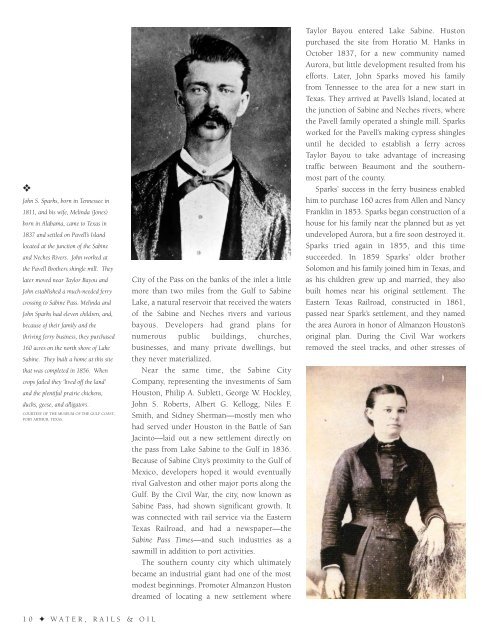Water Rails & Oil - Historic Mid & South Jefferson County
An illustrated history of the Mid and South Jefferson County area, paired with the histories of companies, families and organizations that make the region great.
An illustrated history of the Mid and South Jefferson County area, paired with the histories of companies, families and organizations that make the region great.
Create successful ePaper yourself
Turn your PDF publications into a flip-book with our unique Google optimized e-Paper software.
❖<br />
John S. Sparks, born in Tennessee in<br />
1811, and his wife, Melinda (Jones)<br />
born in Alabama, came to Texas in<br />
1837 and settled on Pavell’s Island<br />
located at the junction of the Sabine<br />
and Neches Rivers. John worked at<br />
the Pavell Brothers shingle mill. They<br />
later moved near Taylor Bayou and<br />
John established a much-needed ferry<br />
crossing to Sabine Pass. Melinda and<br />
John Sparks had eleven children, and,<br />
because of their family and the<br />
thriving ferry business, they purchased<br />
160 acres on the north shore of Lake<br />
Sabine. They built a home at this site<br />
that was completed in 1856. When<br />
crops failed they ‘lived off the land’<br />
and the plentiful prairie chickens,<br />
ducks, geese, and alligators.<br />
COURTESY OF THE MUSEUM OF THE GULF COAST,<br />
PORT ARTHUR, TEXAS.<br />
City of the Pass on the banks of the inlet a little<br />
more than two miles from the Gulf to Sabine<br />
Lake, a natural reservoir that received the waters<br />
of the Sabine and Neches rivers and various<br />
bayous. Developers had grand plans for<br />
numerous public buildings, churches,<br />
businesses, and many private dwellings, but<br />
they never materialized.<br />
Near the same time, the Sabine City<br />
Company, representing the investments of Sam<br />
Houston, Philip A. Sublett, George W. Hockley,<br />
John S. Roberts, Albert G. Kellogg, Niles F.<br />
Smith, and Sidney Sherman—mostly men who<br />
had served under Houston in the Battle of San<br />
Jacinto—laid out a new settlement directly on<br />
the pass from Lake Sabine to the Gulf in 1836.<br />
Because of Sabine City’s proximity to the Gulf of<br />
Mexico, developers hoped it would eventually<br />
rival Galveston and other major ports along the<br />
Gulf. By the Civil War, the city, now known as<br />
Sabine Pass, had shown significant growth. It<br />
was connected with rail service via the Eastern<br />
Texas Railroad, and had a newspaper—the<br />
Sabine Pass Times—and such industries as a<br />
sawmill in addition to port activities.<br />
The southern county city which ultimately<br />
became an industrial giant had one of the most<br />
modest beginnings. Promoter Almanzon Huston<br />
dreamed of locating a new settlement where<br />
Taylor Bayou entered Lake Sabine. Huston<br />
purchased the site from Horatio M. Hanks in<br />
October 1837, for a new community named<br />
Aurora, but little development resulted from his<br />
efforts. Later, John Sparks moved his family<br />
from Tennessee to the area for a new start in<br />
Texas. They arrived at Pavell’s Island, located at<br />
the junction of Sabine and Neches rivers, where<br />
the Pavell family operated a shingle mill. Sparks<br />
worked for the Pavell’s making cypress shingles<br />
until he decided to establish a ferry across<br />
Taylor Bayou to take advantage of increasing<br />
traffic between Beaumont and the southernmost<br />
part of the county.<br />
Sparks’ success in the ferry business enabled<br />
him to purchase 160 acres from Allen and Nancy<br />
Franklin in 1853. Sparks began construction of a<br />
house for his family near the planned but as yet<br />
undeveloped Aurora, but a fire soon destroyed it.<br />
Sparks tried again in 1855, and this time<br />
succeeded. In 1859 Sparks’ older brother<br />
Solomon and his family joined him in Texas, and<br />
as his children grew up and married, they also<br />
built homes near his original settlement. The<br />
Eastern Texas Railroad, constructed in 1861,<br />
passed near Spark’s settlement, and they named<br />
the area Aurora in honor of Almanzon Houston’s<br />
original plan. During the Civil War workers<br />
removed the steel tracks, and other stresses of<br />
10 ✦ WATER, RAILS & OIL
















